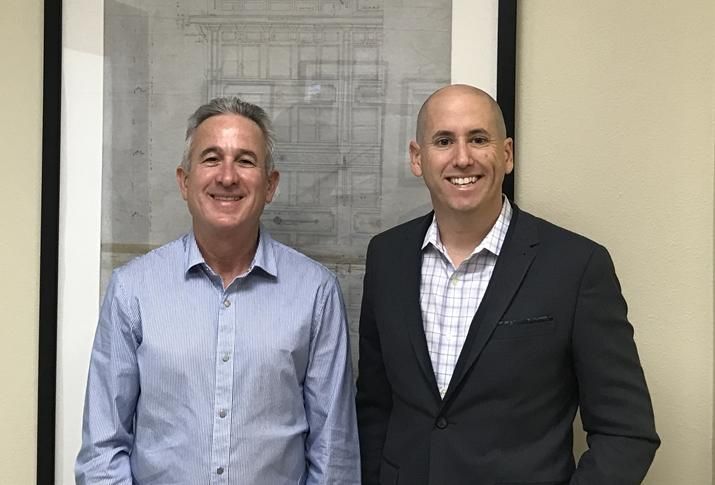UCLA 2018 Economic Forecast
Rent Control on New Developments?
How Koreatown Evolved Into A Development Hot Spot
Iconic Lists - Sanctuary on Kingsley Development Opportunity
Iconic Investments has listed for sale, Sanctuary on Kingsley, a development opportunity in LA's Koreatown submarket. The parcel of land located at 328 N. Kingsley Drive is 28,370 square feet and zoned R3-1. While the current improvements on the property are 20 apartment units, a developer can build up to 48 units
True Costs of Selling an Apartment Building
As you consider selling your investment property, it is essential that you have a clear understanding of what your net proceeds will be at the close of escrow. We will outline typical costs sellers are responsible for, and other costs that are open for negotiation with the buyer. This guide allows you to estimate your net proceeds.
AppFolio- Management Software Review
UCLA Economic Forecast December 2016
Iconic Investments attended the UCLA Anderson Forecast presentation on December 6, 2016. The main theme of the 2017 forecast was “Trumponomics” - how Donald Trump's fiscal policy will affect the US economy, and the elements of his plan. Post-Election, the financial markets have seen an immediate and sharp rise in the stock indices,
Exclusive Q&A with Mark Weinstein
Peter Strauss of Iconic Investments chatted with Mark Weinstein founder and president of MJW Investments about the LA market and his future plans. Mark is leading his firm's expansion in the student housing market as the company, known for its value-add investment and development, continues to search for SoCal multifamily opportunities.
Koreatown Apartment Developers Bring More Retail, Higher Rents for All Owners
Currently in Koreatown, there are more than 5,000 apartment units with 200,000 sq ft of retail either under construction or planned. Most of the projects are ground-up construction, while some developers are converting existing office buildings into apartments. Developers of the new projects expect a stabilized cap rate of 5.5%
Tips On Hiring A Management Company
Relationship - The first step is to feel comfortable with the person you’re doing business with. Remember, you’re hiring someone to shepherd your investment through good and bad, and to strengthen the value of your assets. Make sure that their goals are aligned with yours. They should promote their ability to increase rents, lower expenses, and limit your headaches - especially compared to managing the property yourself.
Communication - As with any relationship, communication is key to success. Ask the candidates how they communication with their clients, and how you can communicate with their owner, staff, on-site managers, and staff. It’s very important that the management candidates are well organized, work well with people, and understand the needs of owners - your needs specifically. Confidentially “shop” other properties that the company manages to determine how quickly they respond to you and how well they are trained. Ask them: “How quickly does the management company respond to service requests?” “Does the management company work well with residents?” Be sure to speak with a variety of on-site managers, and not just the ones at their best buildings.
Geography - It’s important that the management company both specializes in and is located in the same general neighborhood as your property. When maintenance issues arise, the management company needs to respond quickly. If the firm is in the South Bay and your buildings are the Valley, it’s too far. Make sure the management company has other buildings in your area, and maintenance crews are in the area several times a week. I would confirm this by asking for a list of other properties they manage in the area, and then drive by to see the condition of those buildings.
Fees - Management companies are competitive, and compensation varies from building-to- building. Typically, you can expect to pay 5% as a starting fee. If income at your property is low, or your building is small (under 25 units), you can expect a fee of $35-40 per unit per month. Management companies charge additional fees for repairs, renovation of units, advertisement, signage, and preparing of paperwork. You can work with the management company to establish a budget and even give the company the right to initiate repairs below certain thresholds without asking every time. Final tip: be sure to ask if the management company charges a fee on top of vendors’ invoices.
Accounting & Reports - Professional management companies typically use Yardi Voyager or AppFolio, both have powerful bookkeeping and accounting software package designed specifically for property management. Yardi Voyager or AppFolio allows you to go online and instantly access current rent rolls, income statements, profit and loss statements, and a variety of other reports. Depending on how the software is utilized, management companies can be very specific on reporting costs. Expenses can be broken down to specific categories, and shown on a gross, per-unit, or per-square foot basis. Before hiring a management company, make sure their reports are approved by your accountant who will be preparing your taxes.
Vacant units - Make sure to ask what services the management company will provide when you have a vacancy. How will they market the property, screen prospective tenants, and most importantly, ensure that your unit gets filled quickly and at top dollar? Most property management companies rely on Westside Rentals, Craigslist, Hot Pads, Rad Pad and management company websites, and banners. Check out the properties the companies have listed on these sites. Is the listed unit well described? Does it have multiple pictures of both the interior and exterior of the property? Strong online presentation is very important - many prospective renters make up their mind based on the pictures they see online.
Initial meeting - In your initial meeting, you should have prepared notes on your expectations and needs, and make sure that the candidates can satisfy them. Make sure to cover staff, field supervisors, maintenance crew, bookkeepers and on-site managers. Make sure to outline what level of involvement, if any, you want in the management of the property.Tip: During the walk-through of your property, a good property manager should notice things that are wrong with your building, and be quick to give advice and answers on how to resolve the issues, including estimated costs
Earthquake Retrofit Law Explained
Introduction
In October 2015 the Los Angeles City Council unanimously approved one of the nation’s toughest retrofitting ordinances, mandating seismic upgrades aimed at improving earthquake safety in over 14,000 buildings throughout the city. This ordinance directly affects owners and tenants of apartment buildings built prior to 1978 with soft, open, or weak wall lines. This typically corresponds to building sections supported by slender columns with larger tuck-under parking at the ground level. These properties have been deemed to be most at risk in an earthquake event.
In this guide, we’ll help you to understand if and how this ordinance may affect you and your tenants, and how to navigate the complex process of compliance. We believe every owner should be informed.
Overview
Why the proposed law?
Moderate to severe earthquakes are common in Los Angeles and throughout California. The 1994 Northridge earthquake killed 57 people, many resulting from collapses of soft-story apartment buildings, and caused approximately $20 billion in damage. At the time it was considered to be one of the deadliest and most expensive natural disasters in US history.
The likelihood of another major earthquake occurring in Los Angeles is high, and city officials want to minimize both the potential for loss of life and economic impact. City officials acknowledge it is not a question of if, but when.
Who will it affect?
The Los Angeles City Council and Mayor Garcetti’s office recently approved a mandatory seismic strengthening ordinance that affects two groups of buildings known to be vulnerable to earthquake damage. These are:
- Wood framed multi-family buildings with areas of tuck- under parking - with soft line or weak line configurations - that were constructed under permits filed before January 1, 1978.
- Non-Ductile Concrete Buildings constructed prior to January 13, 1977
The “soft story” or soft line/weak line building configuration is common to apartment buildings in Los Angeles, and is known to be especially vulnerable to earthquake damage and potential collapse. The proposed ordinance will require landlords to reinforce and strengthen these properties. The Los Angeles Department of Building and Safety has so far pre-identified approximately 13,000 buildings within the city limits that have a condition.
The ordinance, which is now law, requires owners of vulnerable buildings to complete seismic upgrades within 7 years once they are notified that their buildings must be strengthened. Within 2-years after service of the order the Building Owner must submit to the Building Department a structural analysis and/or plans that demonstrate compliance or include the proposed structural alteration to meet the requirements of Division 93. Within 31⁄2-years after service of the order, property owners must obtain all necessary permits for rehabilitation or demolition.
When will owners be notified?
The ordinance, in it’s current form, has designated priorities to help in the implementation and enforcement. These priorities focus on buildings presenting greatest risk to loss of life first. The priorities are as follows:
Priority I: Buildings with 16 or more units;
Priority II: Buildings with 3 or more stories, and 16 or less units;
Priority III: Buildings not falling under the definitions of Priority I or II.
It is important to note that, once an owner is given notification of retrofit requirements on their property, a notice of work required is recorded on title.
What's involved?
A SWOF (Soft, Weak or Open Front) retrofit will typically include the addition of steel moment frames along the open parking areas and are designed to not obstruct the existing parking. Walls surrounding the parking areas may require strengthening with plywood structural panels before new finishes or stucco is re-applied.
How much will it cost?
The cost of such retrofits vary widely and will likely range between $30,000 to $250,000 for wood-frame buildings, and likely over $1 million for concrete structures.
Costs are totally dependent on the specific building configuration and scope of work. Construction durations for soft-line strengthening are often 60-days (+/-) and must be carefully planned to avoid tenant relocation or habitability disruptions.
The design, acquisition of building permits, tenant notifications, and construction coordination can be compressed into 6-months but often take longer due to variables.
What are the current codes?
The building codes currently in force 2014 LABC and 2013 CBC do not provide perfect guidance to Engineers on how to address SWOF conditions. Additionally, there are a variety of methodologies in existance to improve building strength and stability. This has been a source of confusion among practicing structural engineers and building officials.
The ordinance draws from model codes but is expected to only target localized SWOF deficiencies and not the entire building (except in rare cases) - thereby limiting the scope and the costs. The performance outcome is to create a more earthquake resilient Los Angeles.
Are there any financing options?
New funding and financing options are developing such as:
A proposal is currently before the City Council that would allow owners of rent controlled properties subject to the ordinance to pass a portion of the costs to tenants through a rental increase. The exact dollar amount and time-frames have not yet been finalized, but the Council is debating a rate of between $38 and $50 per month for five or seven years. At best, this option will allow owners to recapture some of the actual costs associated with retrofit.
Property owners may also elect to pursue creative financing solutions - essentially secondary loans - available through lending programs that include the AllianceNRG PACE.
Governor Brown recently vetoed AB428, a bill which would have provided owners with a 30% tax break on the costs of retrofit. New legislation may arise to fill this gap.
Tips On Lowering Your Expenses
While most owners focus on creating income growth through rent increases and unit turnover, top-performing owners intensely focus on expense reduction and management of controllable items. Simply put, in today’s market a simple reduction of overall expenses by $4,000 per year = $100,000 of increased property value.
I always suggest that clients inspect their books and buildings at least twice a year looking for cost-cutting opportunities. Here are some good places to start:
Utilities
Water
Overcrowding is a common reason for high utility bills. Make sure the number of tenants in the unit is equal to the number of people on the lease.
Check all units for leaky showers, tubs, faucets, and running toilets.
Replace toilets to dual-flush or low-flush systems, minimizing the amount of water used - you can get significant rebates or even free toilets from the LADWP.
Install low-flow shower heads & faucet aerators.
Electric
Replace all common area lights with LED.
If your building is master metered, incorporate added fees for the use of wall/window air- conditioning units.
Gas
- Switch to high-efficiency dryers. Rebates available.
- Check your water heater yearly for sediment build-up to ensure proper heating and reduce gas bills.
- Replace aging water heaters with on-demand systems.
Landscaping
“Go Green” with your landscaping and use sustainable plants to limit water usage.
- Drip irrigation systems and rotating sprinkler nozzles are 30-50% more efficient than traditional sprinklers.
- Replace grass with synthetic grass or other ground covering such as dwarf myrtle, mondo grass, bark, or decomposed granite.
- Install a smart sprinkler controller that automatically adjusts watering time and frequency based on weather.
Insurance & Trash
Top-performing owners shop their insurance yearly looking for the best rate possible. They combine multiple properties onto policies, and enure that their coverages match their needs. One client recently told me how he reduced his insurance from $4,800 to $2,600 on a $1.2 million property just by making a few calls to his insurance agents.
Trash removal is another source of potential savings. Last year’s financial review, I suggested a client shop his rubbish removal service. This suggestion lead to a 50% reduction in costs, from $1,400 per month to $750 per month, on a 24-unit building. It pays to shop around. A few minutes could save you hundreds and earn you thousands.
Maintenance & Repairs
Most landlords don’t realize labor costs typically exceed material costs. The best way to reduce ongoing maintenance and repair costs is to use higher quality and more durable materials. Top performers will spend a little extra for the shower valves with solid brass fittings, kitchen faucets with metal spouts, durable porcelain tile or thicker 12mm laminate flooring. Spending a little more on materials up front could save you big in the long run. Here are afewmoresuggestions:
Roofs
Take preventative measures to avoid roof leaks and issues by having a qualified roofer inspect your roof yearly and make minor repairs. This is especially important in this “El Niño” year.
Plumbing
Jet your sewer lines every 6-12 months to prevent messy back-ups and clogs. The jetting process removes built-up debris in the pipes and will greatly reduce your plumbing bills. Top-performing landlords also remove garbage disposals and add strainers to showers to help prevent clogs.
Water Pressure Regulator
Regularly ensure that your water pressure regulator is at the correct PSI. If pressure is too high it can cause water heater and other leaks, lead to dripping faucets, and erode pipes. Using correct water pressure will also reduce your sewer bills as less water is passing through the system.
Press Release- Iconic Investments sells Sherman Apartments
LA's apartment market is so hot, even a building that's 42% vacant with zero cash flow can find a buyer like Lion Real Estate Group, which snapped up the 60unit Sherman Apartments with plans to renovate the Koreatown property for urban professionals. The property traded at a 1.34% cap rate on inplace rents.
Both sides were represented by Iconic Investments' Peter Strauss, who tells us the biggest hurdle wasn't the building's vacancy but rather the extensive work required. The buyer needs to gut 23 units down to the studs and put in all new systems: plumbing, electrical, roofing. "This wasn't just an apartment building with a large number of vacancies. This was literally a construction project." Every major buyer in LA looked at the property, he says. "We had over 20 property tours that yielded seven offers, and led to a bestandfinal pool of three buyers." Lion, which owns and operates more than 600 units in LA, plans to spend $1.2M on improvements in order to reposition the property to appeal to young urban professionals. Rents average $650 to $750 for a studio unit, likely increasing to the $1,095 to $1,195 range after everything's done, but he expects it will be six to 12 months before the buyers see any cash flow.
Sherman Apartments' seller, a Commerce based private investor, owned the building for more than 40 years. The property was built in 1926 and is near three Metro stations in a gentrifying area of Koreatown, Peter says. He's seeing large numbers of people relocate to LA from New York and Boston for work, and these folks are accustomed to riding the subway. “To live in Koreatown just feels right, and they get these beautiful 1920s properties similar to what they had back east.” Peter's family includes wife Paula, son Ethan, and the newest addition: onemonthold daughter Ruby.









